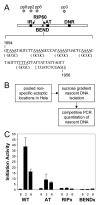Discrete functional elements required for initiation activity of the Chinese hamster dihydrofolate reductase origin beta at ectopic chromosomal sites
- PMID: 17078947
- PMCID: PMC1810229
- DOI: 10.1016/j.yexcr.2006.09.020
Discrete functional elements required for initiation activity of the Chinese hamster dihydrofolate reductase origin beta at ectopic chromosomal sites
Abstract
The Chinese hamster dihydrofolate reductase (DHFR) DNA replication initiation region, the 5.8 kb ori-beta, can function as a DNA replicator at random ectopic chromosomal sites in hamster cells. We report a detailed genetic analysis of the DiNucleotide Repeat (DNR) element, one of several sequence elements necessary for ectopic ori-beta activity. Deletions within ori-beta identified a 132 bp core region within the DNR element, consisting mainly of dinucleotide repeats, and a downstream region that are required for ori-beta initiation activity at non-specific ectopic sites in hamster cells. Replacement of the DNR element with Xenopus or mouse transcriptional elements from rDNA genes restored full levels of initiation activity, but replacement with a nucleosome positioning element or a viral intron sequence did not. The requirement for the DNR element and three other ori-beta sequence elements was conserved when ori-beta activity was tested at either random sites or at a single specific ectopic chromosomal site in human cells. These results confirm the importance of specific cis-acting elements in directing the initiation of DNA replication in mammalian cells, and provide new evidence that transcriptional elements can functionally substitute for one of these elements in ori-beta.
Figures






Similar articles
-
The Chinese hamster dihydrofolate reductase replication origin beta is active at multiple ectopic chromosomal locations and requires specific DNA sequence elements for activity.Mol Cell Biol. 2001 Feb;21(4):1098-110. doi: 10.1128/MCB.21.4.1098-1110.2001. Mol Cell Biol. 2001. PMID: 11158297 Free PMC article.
-
Defined sequence modules and an architectural element cooperate to promote initiation at an ectopic mammalian chromosomal replication origin.Mol Cell Biol. 2004 May;24(10):4138-50. doi: 10.1128/MCB.24.10.4138-4150.2004. Mol Cell Biol. 2004. PMID: 15121836 Free PMC article.
-
Specific signals at the 3' end of the DHFR gene define one boundary of the downstream origin of replication.Genes Dev. 2005 May 1;19(9):1053-66. doi: 10.1101/gad.1307105. Genes Dev. 2005. PMID: 15879555 Free PMC article.
-
Mammalian origins of replication.Bioessays. 1992 Oct;14(10):651-9. doi: 10.1002/bies.950141002. Bioessays. 1992. PMID: 1365877 Review.
-
Transcriptional regulation of the dihydrofolate reductase/rep-3 locus.Crit Rev Eukaryot Gene Expr. 1994;4(1):19-53. doi: 10.1615/critreveukargeneexpr.v4.i1.20. Crit Rev Eukaryot Gene Expr. 1994. PMID: 7987046 Review.
Cited by
-
Distinct epigenetic features of differentiation-regulated replication origins.Epigenetics Chromatin. 2016 May 10;9:18. doi: 10.1186/s13072-016-0067-3. eCollection 2016. Epigenetics Chromatin. 2016. PMID: 27168766 Free PMC article.
-
A revisionist replicon model for higher eukaryotic genomes.J Cell Biochem. 2008 Oct 1;105(2):321-9. doi: 10.1002/jcb.21828. J Cell Biochem. 2008. PMID: 18680119 Free PMC article. Review.
-
Decreased replication origin activity in temporal transition regions.J Cell Biol. 2009 Nov 30;187(5):623-35. doi: 10.1083/jcb.200905144. J Cell Biol. 2009. PMID: 19951913 Free PMC article.
-
Chromatin structure and replication origins: determinants of chromosome replication and nuclear organization.J Mol Biol. 2014 Oct 9;426(20):3330-41. doi: 10.1016/j.jmb.2014.05.027. Epub 2014 Jun 4. J Mol Biol. 2014. PMID: 24905010 Free PMC article. Review.
-
Tetrahymena ORC contains a ribosomal RNA fragment that participates in rDNA origin recognition.EMBO J. 2007 Dec 12;26(24):5048-60. doi: 10.1038/sj.emboj.7601919. Epub 2007 Nov 15. EMBO J. 2007. PMID: 18007594 Free PMC article.
References
Publication types
MeSH terms
Substances
Grants and funding
LinkOut - more resources
Full Text Sources

